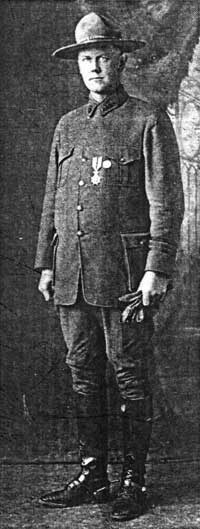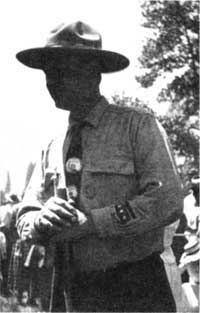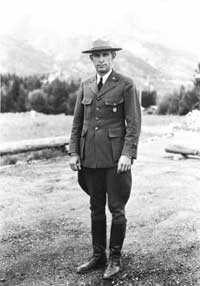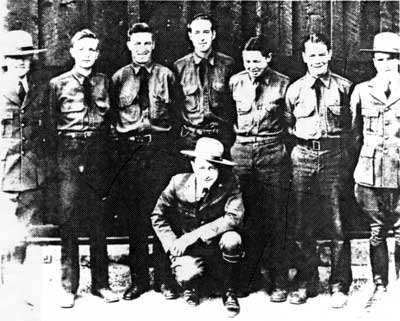![]()
MENU
BADGES
ORNAMENTATION
Arrowhead Patch
Belt
Buttons
Cap Insignia
Collar Ornaments
Hat
Hatband & Straps
Law Enforcement Insignia
![]() Length-of-Service Insignia
Length-of-Service Insignia
Nametags
Sleeve Brassards
Tie Ornaments & Pins
Miscellaneous
Conclusion
Photofile
Appendix
Bibliography
Notes

BADGES and UNIFORM ORNAMENTATION
of the NATIONAL PARK SERVICE
ORNAMENTATION: Length-of-Service Insignia
Some employees had been around since long before the formation of the National Park Service, entitling them to an abundance of stars and stripes. "A man with fifteen or twenty years of service looks like a rear admiral," Frank Pinkley commented. [71] This situation was alleviated in 1930 by Office Order No. 204, which introduced gold stars to represent ten years of service. They lasted only until Office Order No. 324 of April 13, 1936. revamped the stripes and silver stars as follows:
|
The first Length-of-Service (LoS) designation was authorized at the national parks conference held in San Francisco on January 9, 1915. It consisted of a stripe on the sleeve for each five years with the park service. The correspondence authorizing these stripes does not specify color, size, material, nor location, but a photograph of Forrest Townsley taken in 1919 at Grand Canyon National Park shows him wearing three dark bands of tape, presumably black, around the top of the cuff of his left sleeve. These appear to be similar to that worn by Army staff officers. If so, they are probably 1/2" wide. Since Townsley entered the park system in 1904, giving him fifteen years service in 1919, it can be assumed that these three stripes are those mentioned in the above communique. With the 1920 uniform regulations, the single black stripe was regulated to one year of service, with a silver star taking its place for five years. These insignia were to be sewn on the left sleeve of the coat, as well as the shin, with the lowest device being 2-1/2 inches from the end. The stripes were originally to be "narrow black silk braid 3 inches long" but when the regulations were issued they specified "A service stripe of black braid 1/8" wide by 2 inches long" The stars were to be "embroidered white" (silver). Both the embroidered stars and the applied braid were issued on long, three inch wide strips of unbound forest green serge, which may account for the earlier discrepancy. Apparently the edges of the material were to be turned and basted onto the coat sleeve, and in the case of the stripes, leaving two inches of the braid exposed. However, photographs show stripes of varying lengths resulted when left to the individual. Trying to turn the soutache (braid) and keep it neat was also a trick. Although not specified in the regulations, photographs show that the normal practice was for the stripes to be below the stars when worn together, with the stars pointing down.
| ||
The new regulations also addressed the problem of the stripe uniformity as well. They were still applied on long 3 inch wide rolls of unbound forest green serge, but now. the stripes, instead of tape, were embroidered 1/8 inch by 2 inches long on it. The order also stated that "When more than one star is worn, they shall be arranged horizontally up to four and triangularly when more than four stars are worn." The "triangularly" part caused some problems later until it was decided that the fifth star would be centered over the bottom four and subsequent stars would contribute to an expanding pyramid. Stars came in units of one to six. Units of one to four were arranged horizontally, while five and up were to be arranged triangularly. (seven stars - unit of four and a unit of three; eight stars - unit of five and unit of three; etc.) Until 1956 the service stars were made up on a continuous roll, same as the stripes. When cut and applied to the sleeve, the serge material often unraveled and took on a ragged appearance if not sewn properly. That year, Charles C. Sharp suggested that they be made up on neat cloth panels, of from one to six stars each. This solved the problem. [72] Also in 1956, with some personnel reaching very long service, it was decided that when seven stars were worn, the bottom row would contain five stars. The 1961 uniform regulations eliminated all the stars and stripes, replacing them with Department of the Interior (USDI) pins for service in ten-year increments from ten to fifty years. These pins, worn at the discretion of the employee, featured a buffalo with U.S. DEPARTMENT OF THE INTERIOR in an arc over the top and the year designation across the bottom. They were all bronze, but each year had a different background color. In 1972 the Service switched to pins supplied by the General Services Administration (GSA). These consisted of an eagle over a shield containing the years, with DEPT. OF THE INTERIOR on a ribbon underneath. They were bronze for ten years, silver for twenty years, and gold for thirty years and above, again with different colored backgrounds. The pins changed again in 1987. This time they came from the Office of Personnel Management (OPM) and consisted of the national eagle emblem, complete with wreath of stars over the top. Again they came in bronze, silver, and gold, but there was no wording on them, only the years designation at the bottom. All of the designations had a blue background. In 1990 the Service reverted to the Interior pin. These are now considered personal adornment and discouraged from being worn on the uniform. As in previous cases, the earlier pin continued to be issued until the stock was depleted.
| |||
Continue

|
Last Modified: Fri, Jan 17 2003 07:08:48 am PDT
http://www.cr.nps.gov/history/online_books/workman1b/voln.htm
![]()





 Top
Top